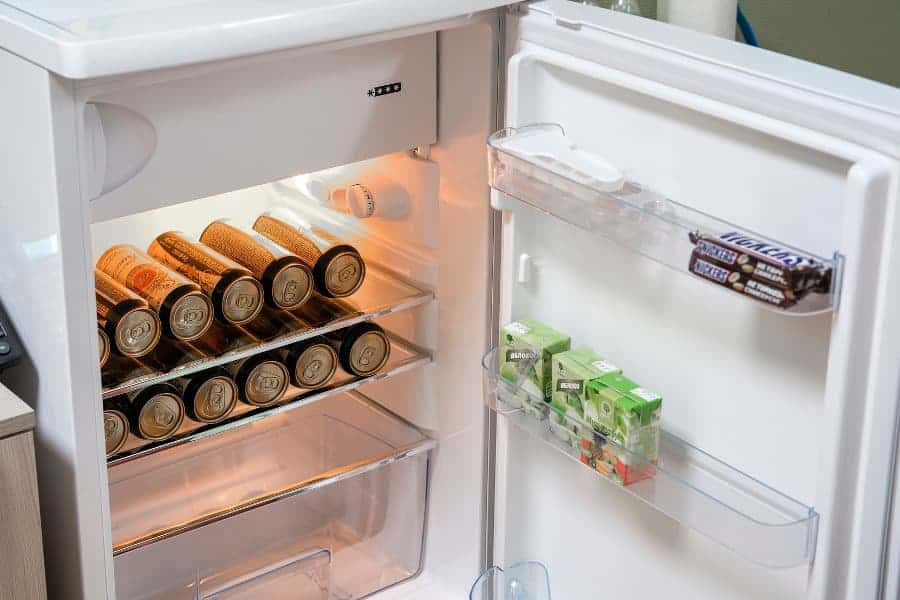Mini fridges are a popular choice for college dorms, small apartments, home offices, and even outdoor patios. They are compact, convenient, and can fit almost anywhere. However, when considering a mini fridge, especially one with a freezer compartment, one question that often comes up is about its energy consumption. At TheKitchenApplianceDad.com, we understand the importance of both convenience and efficiency in kitchen appliances, so let’s dive into how many watts a mini fridge with freezer uses and explore ways to reduce it.
Understanding Energy Consumption in Mini Fridges
Mini fridges with freezers vary in their energy consumption based on their size, model, and how they’re built. Generally, the wattage for mini fridges can range anywhere from 50 watts to over 100 watts. To give you a clearer idea, a typical mini fridge with a freezer might use around 80-100 watts when running. However, it’s important to note that the fridge doesn’t run all the time. It cycles on and off throughout the day, depending on the internal temperature and the ambient conditions.
Factors That Affect Energy Use
Several factors can influence how much energy a mini fridge with a freezer consumes:
- Size and Capacity: Larger mini fridges typically use more energy.
- Insulation Quality: Models with better insulation are more efficient as they keep cold air in more effectively.
- Thermostat Setting: Lower temperature settings increase energy use.
- Usage Frequency: Frequent opening and closing of the fridge can lead to higher energy consumption as the compressor works harder to cool down the warm air that enters.

How to Calculate the Energy Consumption
To calculate how much energy your mini fridge with freezer uses, you can follow this simple formula:
- Find out the wattage: This information can usually be found on the back of the fridge or in the owner’s manual.
- Estimate the running time: For simplicity, assume it runs about one-third of the time (8 hours a day).
- Calculate daily usage: Multiply the wattage by the number of running hours.
- Convert to kilowatt-hours (kWh): Since energy is billed in kWh, divide the daily usage by 1000.
- Estimate monthly usage: Multiply the daily kWh by 30.
For example, if a mini fridge uses 100 watts:
- Daily usage = 100 watts x 8 hours = 800 watt-hours/day
- Daily kWh = 800 watt-hours / 1000 = 0.8 kWh
- Monthly kWh = 0.8 kWh x 30 days = 24 kWh
Energy Efficiency Tips: Reducing Consumption
Minimizing the energy consumption of your mini fridge not only helps in reducing electricity bills but also contributes to environmental conservation. Here are some effective ways to improve the efficiency of your mini fridge:
- Optimal Placement: Keep your mini fridge away from heat sources like stoves, direct sunlight, and heating vents. Also, ensure there’s enough space around it for proper air circulation.
- Regular Maintenance: Keep the condenser coils clean. Dust and debris on the coils can hinder their ability to dissipate heat, making the fridge work harder.
- Check Door Seals: Make sure the door seals are tight and not worn out. Poor seals lead to cold air escaping, which makes the fridge work harder to maintain the temperature.
- Avoid Overloading: Overloading the fridge can block air vents and restrict airflow, leading to increased energy use. Conversely, keeping it too empty can also be less efficient. Aim for a balanced load.
- Thermostat Settings: Set the thermostat to an optimal temperature—around 37°F for the fridge and 0°F for the freezer. Each degree lower consumes more energy.
- Defrost Regularly: If your mini fridge is not frost-free, regular defrosting is necessary to keep it running efficiently.
- Energy Star Rating: Consider purchasing a mini fridge with an Energy Star rating. These models meet strict energy efficiency guidelines set by the U.S. Environmental Protection Agency.
Conclusion
A mini fridge with a freezer can be a handy addition to any space, but it’s important to be mindful of its energy consumption. By understanding how many watts your mini fridge uses and implementing strategies to reduce its energy consumption, you can enjoy the convenience without incurring high electricity costs.
Key Takeaways
- Energy Consumption: Mini fridges with freezers typically use between 80 to 100 watts but cycle on and off, affecting actual consumption.
- Factors Influencing Energy Use: Size, insulation quality, thermostat settings, and usage frequency all play a role.
- Reducing Consumption: Placement, maintenance, and optimal settings can help lower energy use.
- Calculate Usage: Understanding and calculating your fridge’s energy use can help manage and reduce costs.
Mini fridges are a popular choice for college dorms, small apartments, home offices, and even outdoor patios. They are compact, convenient, and can fit almost anywhere. However, when considering a mini fridge, especially one with a freezer compartment, one question that often comes up is about its energy consumption. At TheKitchenApplianceDad.com, we understand the importance of both convenience and efficiency in kitchen appliances, so let’s dive into how many watts a mini fridge with freezer uses and explore ways to reduce it.


